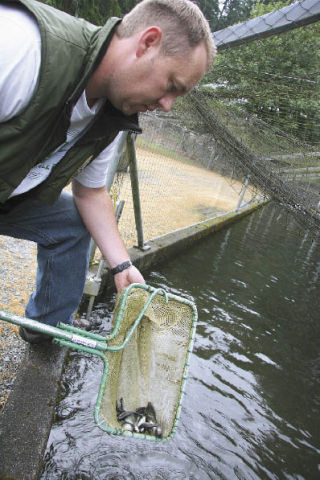on the wild fish of Snoqualmie from our stock of fish,” Combs said. The abundance of hatchery steelheads around Tokul Creek has made it a popular fishing spot, luring crowds into the Valley.
If the hatchery were to close, the Tokul Creek area could be off-limits to sports fishing after the last crop of hatchery fish return to spawn, Combs said. That means that within a couple of years, the area could lose the steady winter stream of visiting fishers who patronize local merchants.
“It’s a lot of people who are buying gas here, buying food. It provides some revenue to the small businesses in the Valley,” Combs said.
Hatchery staff are struggling with the uncertainty of what will happen if their workplace and home closes.
Combs, his family, and two other staff members live on the grounds, so employees can respond to any emergencies 24 hours a day.
“I love the area. It’s a nice setting, quiet. It’s kind of like living on a park,” Combs said of the five-acre property, located on Fall City-Snoqualmie Road.
Hatfield said Combs would likely remain as caretaker, and continue supervising another hatchery in Issaquah. Hatchery technician Duane Richer would probably be relocated to another facility. The staff position held by Debi Sanchez, who has been with the hatchery for 20 years, would be eliminated, Hatfield said.
“We’re very proud of the place, and we work hard at making it look nice, and also raising quality fish. That makes it especially tough,” said Combs, who is waiting with bated breath until a final decision comes down from Olympia.
“The earliest I would anticipate any concrete move would be some time in September,” Hatfield said.
If that move happens, Hatfield expects a backlash.
“When word gets out that a hatchery is proposed for cuts or closure, there’s usually reaction,” he said.
For a century, the Tokul Creek Fish Hatchery has released its stocks into the waters of the Snoqualmie.
Now, the hatchery’s presence in Fall City looks murky, as the Washington Department of Fish and Wildlife considers closing the historic facility.
Because the hatchery releases about 185,000 steelhead trout into the Snoqualmie River every year, a closure would not only change the lives of the three staff members who live and work at the operation, but could also impact the local economy as fewer sport fishers would be drawn to the area, said hatchery manager Darin Combs.
Reasons for closure
The state is looking at closing the facility for financial and environmental concerns, said Doug Hatfield, who oversees hatchery operations from Issaquah to Darrington.
“There’s a substantial shortfall of funds in the Wildlife budget, which fully funds Tokul Creek,” Hatfield said, adding that some hatcheries in southwest Washington might also shut down.
“Conservation considerations” also come into play, with Puget Sound steelheads recently being listed as a “threatened” species, Hatfield said. “Part of the effort of the agency is to come up with plans to ensure the health of stocks going forward, and one step is to establish wildlife fish management zones.”
The Snoqualmie River, he said, has been designated as a sanctuary zone for wild steelhead, which some researchers believe are harmed when they’re forced to compete with hatchery fish.
If the Tokul Creek site were to close, steelhead production would shift to other hatcheries, Hatfield said.
Combs isn’t convinced that the steelheads his hatchery releases hurt the wild fish.
“From what I understand, the latest science says there’s not much of an effect


